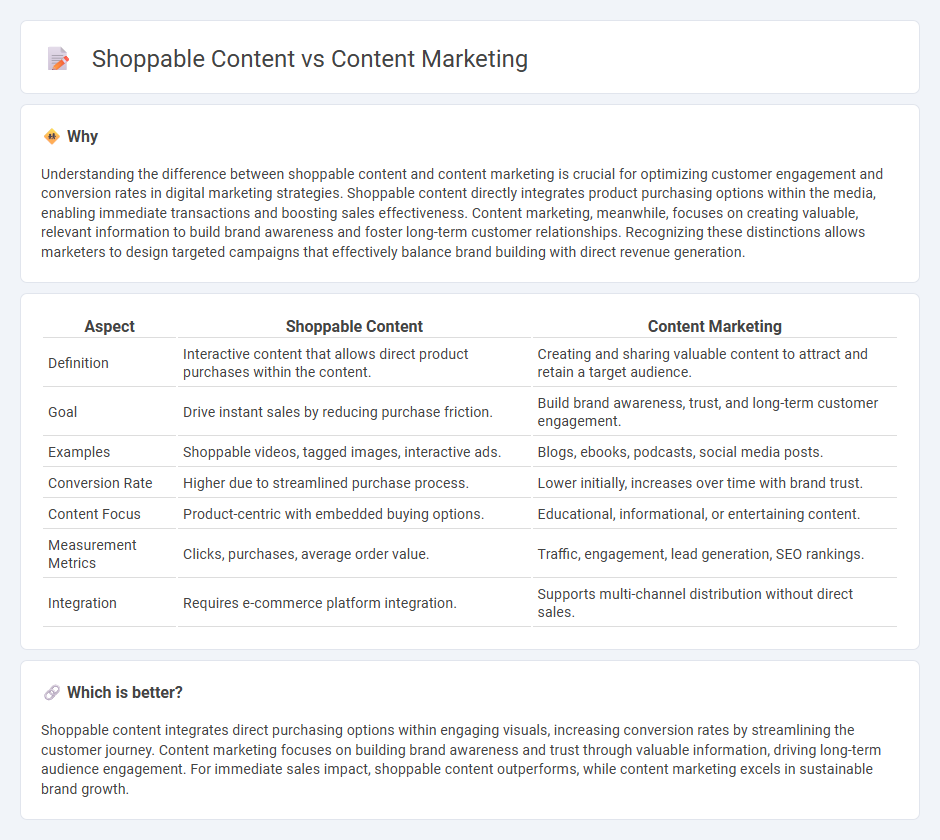
Shoppable content integrates product purchases directly within digital media, streamlining the buying process and enhancing user engagement for e-commerce brands. Content marketing focuses on creating valuable, relevant content to attract and retain a clearly defined audience, driving profitable customer action over time. Explore the distinct advantages and strategies of shoppable content versus traditional content marketing to optimize your marketing efforts.
Why it is important
Understanding the difference between shoppable content and content marketing is crucial for optimizing customer engagement and conversion rates in digital marketing strategies. Shoppable content directly integrates product purchasing options within the media, enabling immediate transactions and boosting sales effectiveness. Content marketing, meanwhile, focuses on creating valuable, relevant information to build brand awareness and foster long-term customer relationships. Recognizing these distinctions allows marketers to design targeted campaigns that effectively balance brand building with direct revenue generation.
Comparison Table
| Aspect | Shoppable Content | Content Marketing |
|---|---|---|
| Definition | Interactive content that allows direct product purchases within the content. | Creating and sharing valuable content to attract and retain a target audience. |
| Goal | Drive instant sales by reducing purchase friction. | Build brand awareness, trust, and long-term customer engagement. |
| Examples | Shoppable videos, tagged images, interactive ads. | Blogs, ebooks, podcasts, social media posts. |
| Conversion Rate | Higher due to streamlined purchase process. | Lower initially, increases over time with brand trust. |
| Content Focus | Product-centric with embedded buying options. | Educational, informational, or entertaining content. |
| Measurement Metrics | Clicks, purchases, average order value. | Traffic, engagement, lead generation, SEO rankings. |
| Integration | Requires e-commerce platform integration. | Supports multi-channel distribution without direct sales. |
Which is better?
Shoppable content integrates direct purchasing options within engaging visuals, increasing conversion rates by streamlining the customer journey. Content marketing focuses on building brand awareness and trust through valuable information, driving long-term audience engagement. For immediate sales impact, shoppable content outperforms, while content marketing excels in sustainable brand growth.
Connection
Shoppable content integrates product links directly into engaging content, enhancing content marketing by streamlining the path from inspiration to purchase. By embedding interactive elements such as buy buttons within blogs, videos, or social media posts, marketers increase conversion rates and drive immediate sales. This synergy leverages storytelling to captivate audiences while providing seamless shopping experiences, aligning brand engagement with revenue growth.
Key Terms
Content Marketing:
Content marketing involves creating valuable, relevant, and consistent content to attract and engage a clearly defined audience, driving profitable customer action. It leverages blogs, videos, infographics, and social media posts to build brand authority and foster long-term relationships. Explore how content marketing strategies can elevate your brand visibility and customer engagement.
Storytelling
Content marketing leverages storytelling to create engaging narratives that build brand trust and foster emotional connections with the audience. Shoppable content integrates direct purchasing options within these stories, enhancing consumer convenience and streamlining the buyer journey. Explore how combining storytelling with shoppable content can drive both engagement and sales.
Audience Engagement
Content marketing drives audience engagement by delivering valuable, informative, and relevant content that builds trust and brand loyalty over time. Shoppable content enhances engagement by integrating interactive elements that allow users to purchase products directly within the content, creating a seamless shopping experience. Explore how these strategies can maximize audience interaction and conversion rates for your business.
Source and External Links
What is Content Marketing? A Beginners Guide - Content marketing is the strategic creation and distribution of valuable, relevant content to attract and engage your target audience, build trust, and drive profitable customer actions.
What Is Content Marketing? - Content marketing is a strategic marketing approach focused on creating and distributing valuable, relevant, and consistent content to attract and retain a clearly defined audience, ultimately driving profitable customer action.
The Complete Content Marketing Guide For 2025 - Copyblogger - Content marketing is a form of inbound marketing that uses useful or entertaining content--like text, video, or audio--to attract users, build relationships, and foster brand trust at scale.
 dowidth.com
dowidth.com